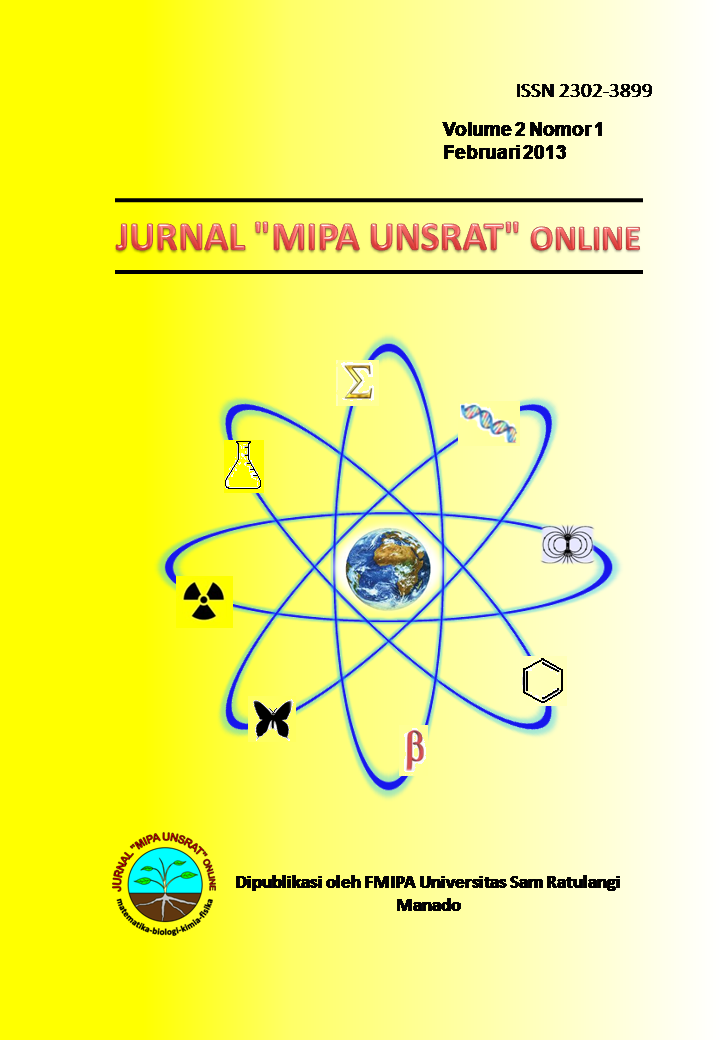Uji Total Flavonoid Pada Beberapa Tanaman Obat Tradisonal Di Desa Waitina Kecamatan Mangoli Timur Kabupaten Kepulauan Sula Provinsi Maluku Utara
DOI:
https://doi.org/10.35799/jm.2.1.2013.766Abstract
Penelitian ini bertujuan untuk menguji total kandungan flavonoid pada beberapa tanaman obat tradisional. Penentuan kandungan total flavonoid dilakukan dengan menggunakan metode etanol – HCl, sedangkan analisis flavonoid menggunakan Metode spektrofotometeyr UV-VIS . Hasil yang diperoleh menunjukan kandungan total flavonoid pada tanaman ketepeng cina (Cassia alata L) sebesar 26.8633 mg/mL , iler (Coleus scutellariodes L Benth) sebesar 14.425 mg/mL , rumput teki (Cyperus rotundus L) sebesar 6.505 mg/mL, pegagan (Centella asiatica) sebesar 3.816 mg/mL, rumput mutiara (Oldenlandia corymbosa) sebesar 2.686 mg/mL dan waru (Hibiscus tiliaceus L) sebesar 1.425 mg/mL. Kandungan total flavonoid tertinggi terdapat pada daun ketepeng sebesar 26.863 mg/mL, sedangkan kandungan flavonoid terendah terdapat pada daun waru sebesar 1.425 mg/mL. Analisis flavonoid dilakukan pada 𜆠= 200 - 400 nm dan ðœ†maks = 205 nm. Hasil analisis flavonoid menunjukkan bahwa [A] daun iler panjang gelombang maksimum yaitu 205 nm dan (pita I) 300 nm dan (pita II) 250 nm dengan absorbansi 0.242 positif mengandung flavonol. [B] daun rumput mutiara panjang gelombang maksimum 205 nm dan dapat dilihat pada (pita I) 305 nm dan (pita II) 260 nm dengan absorbansi 0.023 positif mengandung flavonol. [C]) daun ketepeng panjang gelombang maksimum 205 nm dan dapat dilihat pada (pita I) 330 nm dan (pita II) 276 nm dengan absorbansi 0.167 positif mengandung flavonol. [D]) daun pegagan panjang gelombang maksmum 205 nm dan dapat dilihat pada (pita I) 310 nm dan (pita II) 265 nm dengan absorbansi 0.047 positif mengandung flavonol. (E) rumput teki hanya terdapat (I pita) yaitu 295 nm dengan absorbansi 0.029 positif mengandung flavon. (F) Begitupun dengan daun waru hanya terdapat (I pita) yaitu 290 nm dengan absorbansi 0.036 positif mengandung flavon. Dapat disimpulkan bahwa berdasarkan uji kualitatif tanaman iler, ketepeng, rumput mutiara, rumput teki dan pegagan mengandung flavonoid kecuali tanaman waru tidak terdeteksi kandungan flavonoidnya.
This studyaims to examine the total flavonoid contentin some traditional medicinal plants. Determination of total flavonoid content swere determined using ethanol-HCl, where as flavonoid analysis was analysed by spectrophotometry UV-VIS.The results showed the total flavonoid contentin Ketepeng China plant (Cassia alataL.) was 26.863 mg/ml, Iler plant (Coleus scutellariodes L. Benth) was 14.2464 mg/ml, nut-grass (Cyperus rotundus L.) was 6.505 mg/ml; Pegagan (Centella asiatica) was 3.816 mg/ml; pearl grass (Oldenlandia corymbosa) was 2.686 mg/ml, and Waru (Hibiscus tiliaceus L.) was 1.425 mg/ml. The highest total flavonoid was found in ketepeng(26.8633mg/ml), whereas the lowest was found in waru (1.4246 mg/ml). Flavonoid analysis was performed using a spectrometer with a wavelength (λ) of 200-400 nm, with λmax = 205 nm. Flavonoid analysis using a spectrophotometer, amon others showed that: (1) The maximum wavelength of Iler leaf was 205 nm and can be see non the Band I 300 nm and Band II 250 nm, with 0.242 absorbance. This indicates that this isolate was positive for flavonols; (2) Maximum wavelength of pearl leaf was 205 nm and can be see non the Band I 305 nm and Band II 260 nm, with 0.023 absorbance. This indicates that this isolate was positive for flavonols; (3) Maximum wavelength of ketepeng leaf was 205 nm and can be see non the Band I 330 nm and Band II 276 nm, with 0.167 absorbance. This indicates that this isolate was positive for flavonols; (4) Maximum wavelength of pegagan leaf was 205 nm and can be see non the Band I 310 nm and Band II 265 nm, with 0.047 absorbance. This indicates that this isolate was positive for flavonols; (5) nut-grass had only 1 band, namely 295 nm with absorbance 0.029. This indcates that this isolate was positive for flavons; (6) waru leaf had also only 1 band, namely 290 nm with absorbance 0.036. This this isolate was positive for flavons.





